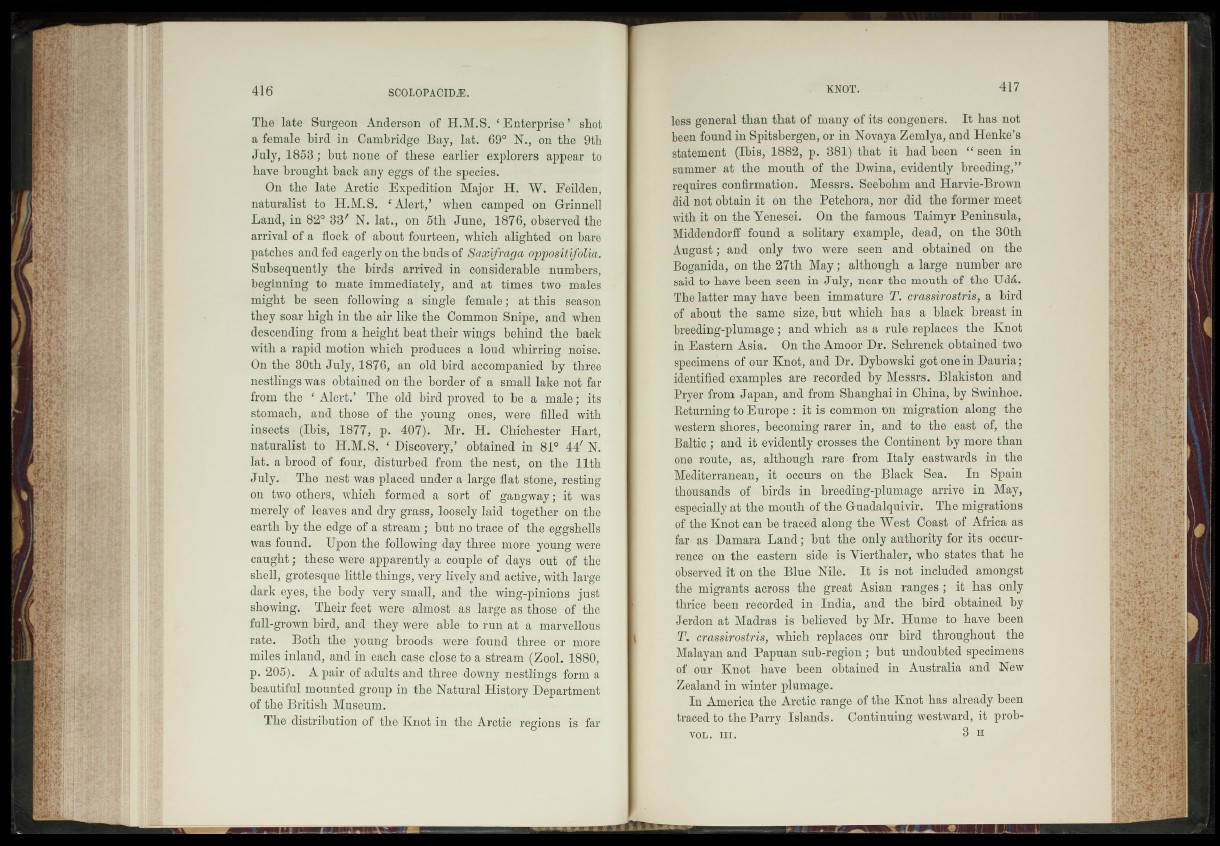
The late Surgeon Anderson of H.M.S. | Enterprise ’ shot
a female bird in Cambridge Bay, lat: 69° N., on the 9th
July, 1853; but none of these earlier êxplorers appear to
have brought back any eggs of the species:
On' the late Arctic Expedition Major H. W. Feilden,
naturalist to H.M.S. ‘Alert,’ when camped on Grinnell
Land, in 82° 88* N. lat., on 5th June, *1876, observed the
arrival of a flock of about fourteen, which alighted on bare
patches and fed eagerly on the buds of Saxifrage oppósétifölia.
Subsequently the birds arrived in considerable numbers,
beginning to mate immediately, and at times" two males
might be seen following a single female; at this season
they soar high in the air like the Common Snipe,1 and when
descending from a height beat their wings behind the3'back
with a rapid motion which produces a loud whirring moise.
On the 30th July, 1876, an- old bird accompanied by “three
nestlings was obtained on the border of a small lake not far
from the ‘ Alert.’ The*-oM Mrdproyéd"to be a male-; its
stomach, and those of the young ones, we,re filled with
insects (Ibis, 1877, p. 407).’~Mr. H. Chichester Hart,
naturalist to' H.M.S. ‘ Discovery,’ pbtained in 81° 44* N.
lat. a brood of four, disturbed from the nest, on the ^ t h
July. The rfpst was placed under a large flat stone; resting
ón two others, which formed a sort |f* gangwayit-»was
merely of leaves and dry grass, loosely laid tögëthëf oh the
earth by the edge of a stream ; but no trace of®the“hggfhe!ls
was found* Upon the following d&y-hhréè meèë'^y'ehn^weré
caught; these were apparently a Vo-uple of days -out of4he
shell/grotësqué little things, very lively and active, with largë
dark eyes, the body very small, and the wingjpihiohs’just
showing. Their f e e t - a lmo s t as "fatge as tïrosh^ff^he
full-grown bird, and they were able^ to run at ar i^weTlbus
rate* Both the-^young brOOds -were found three-or'more
miles inland, and in each case closeto a stream ,(Zb0Lji880,
p. 205);* A pair of adults and three“* %fwny “nestlihgs^lm a
beautiful mounted group in the Natural History Department
of the British Museum.
The distribution of the Knot in-the Arctic regions is far
less general than that of many of its congeners. It has not
been found in Spitsbergen, or in Novaya Zemlya, and Henke’s
statement (Ibis, 1882, p. 381) that _it had been “ seen in
summer at the mouth of the- Dwina, evidently breeding,”
requires confirmation. Messrs. Seebohm and Harvie-Brown
did not obtain it on the Petchora, nor did the former meet
with it on the Yenesei. $ On the famous Taimyr Peninsula,
Middendorff J found, a solitary example, dead, on the 30th
August; and only two were seen and obtained on the
Boganida, on the 27th May; although a large number are
said to'have been seen in July, near the mouth of the^Udä.
The latter may have been- immature T. crassirostris, a bird
of about-the same size, but which has a black breast' in
breeding-plumage; and which as a rule replaces the' Knot
in Eastern Asia. On the Amoor Dr. Schrenck obtained two
specimens of our Knot, and Dr. Dybowski got one in Dauria;
identified examples- are recorded by Messrs. Blakiston and
Pryer- from Japan, and from Shanghai in China;, by -Swinhoe.
Returning to:Europe : it is common on migratipn along the
western shores, becoming rarer in, and to the east of, the
Baltic; and it -evidently-crosses the'CÓntinent by more than
one route, as, although rare* from -Italy eastwards in the
Mediterranean, it -occurs ó$ "the Blaek Sea. Ini Spain
thousands pf.-birds * in .breeding-plumage arrive in Majjg
especially at the mouth .of the Guadalquivir. The migrations
oPthe Knot can be traced along the-'WeSt- Coast of Africa as
far as Damara Land,- but the only authority foriits' occurrence
on the eastern-4i<feJ? is Yierthaler, who states that' he
observed it on the Blue 'Nile.- It is hot included'amongst
the migrants across the great Asian ranges; it has-cn|||
thrice been recorded -in India, and the bird obtained* by
Jerdon at Madras is! believed by Mr. -Hume >tp'’”have been
T&crassiroStriSj which, replaces oür“ .bird throughout the
Malayan and Papuan sub-region ; but undoubted specimens
of: nur .-Knot have been obtained in Australia and' New
Zealand in winter plumage.
In; America the Arctic range of the Knot has already been
traced to the .Parry-Islands. Continuing westward, it -prob-
I ,VOL. III. 3 H